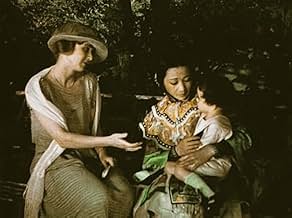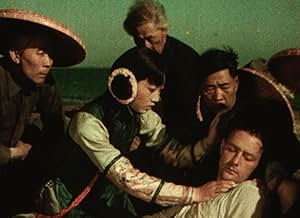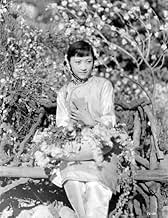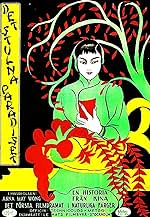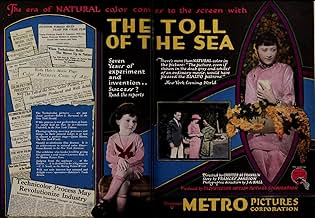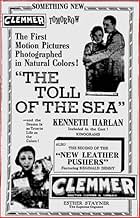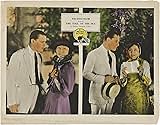Aggiungi una trama nella tua linguaWhile visiting China, an American man falls in love with a young Chinese woman, but he then has second thoughts about the relationship.While visiting China, an American man falls in love with a young Chinese woman, but he then has second thoughts about the relationship.While visiting China, an American man falls in love with a young Chinese woman, but he then has second thoughts about the relationship.
- Premi
- 1 vittoria in totale
Recensioni in evidenza
This movie would be interesting historically if for no other reason than to see its pioneering use of the two-strip Technicolor, which still looks good over 80 years later. It's also well worth seeing to watch Anna May Wong in an early starring role, when she was still a teenager.
The story takes the "Madame Butterfly" plot and changes it slightly, setting it in China and adding some emphasis on the role of the sea. The story is simple, yet potentially packed with emotion, with its themes of clash between cultures and broken promises in relationships. Much of this particular production seems understandably to have been devoted to ways of showing off the potential of its new color process, and as a result there are times when the visual is emphasized over the dramatic potential.
Wong, as you would expect, is quite good in her role. She looks quite young, with plenty of youthful innocence instead of the full degree of elegance that characterized her later roles. But she already had the ability to use the smallest of expressions and gestures to express her character's emotions economically and convincingly.
The rest of the production (other than Wong and the color process) is merely solid for the time. Kenneth Harlan rarely shows much energy as Carver, although fortunately it often works positively in bringing out his character's spineless nature.
The basic story makes some powerful statements about relationships and cultures, and thanks to Wong, much of that comes through. It does miss a few opportunities, but it hits more than it misses, and the combination of Wong plus the chance to see what early Technicolor looked like is more than enough to recommend "The Toll of the Sea" to any silent movie fan.
The story takes the "Madame Butterfly" plot and changes it slightly, setting it in China and adding some emphasis on the role of the sea. The story is simple, yet potentially packed with emotion, with its themes of clash between cultures and broken promises in relationships. Much of this particular production seems understandably to have been devoted to ways of showing off the potential of its new color process, and as a result there are times when the visual is emphasized over the dramatic potential.
Wong, as you would expect, is quite good in her role. She looks quite young, with plenty of youthful innocence instead of the full degree of elegance that characterized her later roles. But she already had the ability to use the smallest of expressions and gestures to express her character's emotions economically and convincingly.
The rest of the production (other than Wong and the color process) is merely solid for the time. Kenneth Harlan rarely shows much energy as Carver, although fortunately it often works positively in bringing out his character's spineless nature.
The basic story makes some powerful statements about relationships and cultures, and thanks to Wong, much of that comes through. It does miss a few opportunities, but it hits more than it misses, and the combination of Wong plus the chance to see what early Technicolor looked like is more than enough to recommend "The Toll of the Sea" to any silent movie fan.
This film has a bit of fame as one of the first films using the process of two tone color. I saw it at MOMA when they were showing a retrospective of the history of color in moving pictures. It was shown without any music and for a silent film this is usually death, but the film was utterly engrossing and terribly moving. I still think of it ten years after I've seen it and would LOVE to get my hands on a copy. Anna May Wong is poignant and fragile in the lead role in this adaptation of the Madame Butterfly story.
This 1922 film is apparently the first feature length film ever made in color, which alone makes it worth watching. It stars the beautiful, incomparable Anna May Wong, who was 17 at the time. She already shows remarkable maturity as an actress. The story unfolds when Lotus Flower discovers a Caucasian man floating in the sea and enlists help to save him. They fall in love and get married. Does the love last? This film is very dramatic, and it lasts under one hour. The story is told simply, with interesting twists in the tale. The film was thought lost for years until it was found, with the ending needing to be re shot. See it for the historical, pioneering aspect of it. But, most important, see it for the great performance of Anna May Wong. This movie cements the brilliant and varied versatility that she had as an actress.
Updating MADAM BUTTERFLY for the twenties was an ideal way to showcase the talents of Anna May Wong, one of the earliest Oriental actors to become a star. The story was further updated, of course, for the theatre musical MISS SAIGON in the 1990s.
The early use of Technicolor seen in this charming if somewhat undemanding picture makes the film more interesting than would normally be the case. An earlier reviewer said it ran at 41 minutes, but my version (on Video CD - compatible with most DVD players) has an accurate running time of 50 minutes - perhaps contains more material. Don't know how long the version runs for on the 'Treasures of the American Archive' DVD.
Worth a look as a curio, and worth treasuring as a piece of cinema history.
The early use of Technicolor seen in this charming if somewhat undemanding picture makes the film more interesting than would normally be the case. An earlier reviewer said it ran at 41 minutes, but my version (on Video CD - compatible with most DVD players) has an accurate running time of 50 minutes - perhaps contains more material. Don't know how long the version runs for on the 'Treasures of the American Archive' DVD.
Worth a look as a curio, and worth treasuring as a piece of cinema history.
This beautifully told story was written by Frances Marion, the highest paid and most famous woman screenwriter of the early film days. It is beautifully photographed in color, one of the first. The story loosely follows Madame Butterfly and is tender and touching.
Lo sapevi?
- QuizThe seventh color feature, the second Technicolor feature, the first color feature made in Hollywood, and the first color feature anywhere that did not require a special projector to be shown.
- Citazioni
Old Chinese Gentleman: Whence comes this foreign face?
Lotus Flower: Alone in my garden I heard the cry of wind and wave. I came hurrying fast - and he was here!
Old Chinese Gentleman: Beware of this stranger! The sea is treacherous. His coming bodes no good!
- Versioni alternativeIn 1985, this film was restored using original negative materials, by Richard Dayton and Pete Comandini of the YCM Laboratories, and Robert Gitt of the UCLA Film and Television Archives, using funds from the AFI/NEA Film Preservation Program. Because the last 3-minute sequence of the Pacific Ocean was missing, it was re-shot using Frances Marion's titles from her scenario and an authentic 2-strip Technicolor camera. The film ran 53 minutes plus about one minute of explanatory information and restoration credits.
- ConnessioniFeatured in Les premiers pas du cinéma - Un rêve en couleur (2004)
I più visti
Accedi per valutare e creare un elenco di titoli salvati per ottenere consigli personalizzati
- How long is The Toll of the Sea?Powered by Alexa
Dettagli
- Data di uscita
- Paese di origine
- Lingua
- Celebre anche come
- Det stulna paradiset
- Azienda produttrice
- Vedi altri crediti dell’azienda su IMDbPro
- Tempo di esecuzione
- 54min
- Mix di suoni
- Proporzioni
- 1.33 : 1
Contribuisci a questa pagina
Suggerisci una modifica o aggiungi i contenuti mancanti

